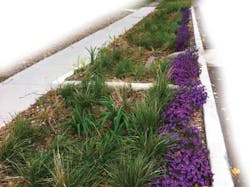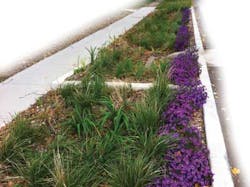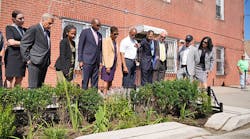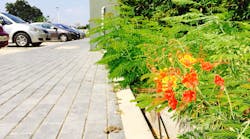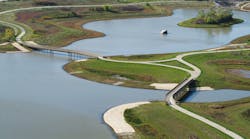It is essential to understand the context and growing conditions when selecting plants for a rain garden, bioretention basin, or other vegetated green solution. Plants that would be perfect for a green solution in a park will be different from those that are appropriate in a residential neighborhood or commercial corridor. Plant species should be selected by qualified professionals trained in planting design because there is no "one-size-fits-all" solution.
There are two general categories of growing conditions present within the Middle Blue Pilot project green solutions: basin bottom and side-slope. The basin bottom is the flat part of the bed that receives the most water and does the majority of the water infiltration. The side-slopes (or edges) slope sharply downward and are highly visible from buildings and streets.
To gain experience on the survivability and performance of plants in a green infrastructure solution, a wide variety of plants were used in the Middle Blue first phase pilot, including native plants, ornamental grasses, and cultivated varieties of native plants.
Plants used in the basin bottoms were selected for their ability to grow robust root systems that encourage water to infiltrate into the soil and withstand varying levels of soil moisture.
Example basin bottom plants:
- Switchgrass Varieties (Panicum virgatum 'Northwind' and 'Shenandoah')
- Soft Rush (Juncus effusus)
- Palm Sedge (Carex muskingumensis)
- Iroquois Beauty Black Chokeberry (Aronia melanocarpa 'Morton')
Plants used on the side-slopes of the basins were selected for their ability to withstand varying levels of soil moisture and for ornamental qualities, such as persistent leaves and flowering.
Example side-slope plants:
- 'Miss Manners' Obedient Plant (Physostegia virginiana 'Miss Manners')
- Wood's Purple Aster (Aster 'Wood's Purple')
- Happy Returns Daylily (Hemerocallis 'Happy Returns')
WaterWorld Articles Archives
